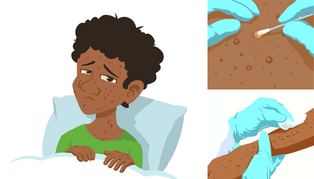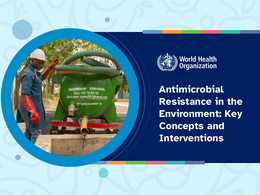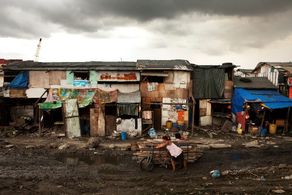当前疫情的课程
所有课程列表 »This course introduces Marburg Virus Disease and outlines the signs, symptoms, diagnosis, transmission routes and epidemiology of the disease. It also discusses prevention and control strategies.
...- 自学
- Current outbreaks, Marburg
- 下载参与证明
- en
Mpox is an emerging infectious disease caused by a virus transmitted to humans from infected animals, most commonly rodents. It can be spread to other people but person-to-person transmission alone...
- 自学
- Current outbreaks, Mpox
- 课程结业证书
- en
Mpox is an infectious disease which in 2022-2023 caused a global outbreak in over 110 countries, most of which had no previous history of the disease. This course provides a brief overview of mpox,...
- 自学
- Current outbreaks, Mpox
- 课程结业证书
- en + 7 字幕
Dengue is a viral infection caused by the dengue virus (DENV), transmitted to humans through the bite of infected mosquitoes. An estimated 100-400 million infections occur each year. This course pr...
- 自学
- , Current outbreaks
- 课程结业证书
- en
All health and care workers require the knowledge and skills to prevent the transmission of Ebola virus or Marburg virus when providing care for patients. This course provides an overview of the mo...
- 自学
- Current outbreaks, Ebola, Marburg
- 课程结业证书
- en
免费学习
轻松访问
探索知识
最新课程
所有课程列表 »The civil-military collaboration can play a unique and powerful role in strengthening health emergency preparedness through its various capacities and capabilities such as logistical support, medic...
- 自学
- 课程结业证书
- en + 1 字幕
All healthcare workers who use medical oxygen systems should understand the whole oxygen ecosystem and should be able to outline safety considerations of oxygen systems implemented in their facilit...
- 自学
- Health topic
- 下载参与证明
- en
The global clinical trials enterprise is growing worldwide. However, many parts of the world, especially low- and middle-income countries (LMICs), lack sufficient clinical trial capacity, meaning s...
- 自学
- 课程结业证书
- en + 1 字幕
Research is a vital ingredient for improved global health. To advance ethically sound research, researchers and research ethics committee members must be prepared to identify and respond to ethical...
- 自学
- 课程结业证书
- en + 1 字幕
Atopic dermatitis is one of the common skin diseases globally and is often co-endemic with many skin neglected tropical diseases. This course provides comprehensive information about the cause, di...
- 自学
- NTD
- 课程结业证书
- en
La dermatite atopique est l'une des maladies cutanées les plus courantes dans le monde et est souvent co-endémique avec de nombreuses maladies cutanées tropicales négligées. Ce cours fournit des in...
- 自学
- NTD
- 课程结业证书
- fr
All health and care workers require the knowledge and skills to prevent the transmission of Ebola virus or Marburg virus when providing care for patients. This course provides an overview of the mo...
- 自学
- Current outbreaks, Ebola, Marburg
- 课程结业证书
- en
This course builds upon the WHO guidance and adapted introductory online course Ethics and Governance of Artificial Intelligence for Health, aiming to guide programmers, designers, data scientists ...
- 自学
- Health topic
- 课程结业证书
- en + 1 字幕
Antimicrobial resistance (AMR) is one of the leading threats to human health. Tackling AMR will require a One Health response, including addressing AMR in the environment. The environmental dimensi...
- 自学
- Health topic
- 课程结业证书
- en + 1 字幕
Large gaps in access to WASH, waste and electricity services in health care facilities exist worldwide. The WHO/UNICEF Water and Sanitation for Health Facility Improvement Tool (WASH FIT) helps fac...
- 自学
- 课程结业证书
- en + 1 字幕
Dental amalgam has been used as a restorative material to address dental caries and is one of the contributors to mercury consumption across the globe. The Minamata Convention on Mercury is a globa...
- 自学
- Health topic
- 课程结业证书
- en
This course provides an orientation for the health workforce of the Member States in the South-East Asia Region on the latest relevant guidance and expert experience on clinical case management acr...
- 自学
- 下载参与证明
- en + 1 字幕
यह पाठ्यक्रम दक्षिण-पूर्व एशिया क्षेत्र के सदस्य देशों के स्वास्थ्य कार्यबल को क्षेत्र भर में नैदानिक मामला प्रबंधन पर नवीनतम प्रासंगिक मार्गदर्शन और विशेषज्ञ अनुभव पर अभिमुखीकरण प्रदान करता है, ...
- 自学
- 下载参与证明
- hi
Cystic echinococcosis is a human parasitic disease caused by the tapeworm Echinococcus granulosus sensu latu. The life cycle of this parasite involves a carnivorous definitive host (typically dogs)...
- 自学
- 课程结业证书
- en
WHO is the signatory to numerous global Accountability to Affected People (AAP) commitments through the Inter Agency Standing Commitments and the Grand Bargain. This training will introduce emergen...
- 自学
- Health topic
- 课程结业证书
- en
This course is intended to introduce participants to WHO’s Global Programme to Eliminate Lymphatic Filariasis (GPELF), specifically focusing on the strategies to reduce suffering among persons affe...
- 自学
- NTD
- 课程结业证书
- en
Health workers play a vital role in providing people-centred health services and building the resilience of health systems to respond to the health needs of refugees and migrants. This course enhan...
- 自学
- Health topic
- 课程结业证书
- en + 1 字幕
This 2-hour course, delivered across 4 modules, provides health professionals—including WHO staff, policymakers, frontline managers, and clinicians—with essential knowledge about the social determi...
- 自学
- Health topic
- 课程结业证书
- en
The aim of this course is to introduce the concept and content of the WHO people-centred approach to addressing antimicrobial resistance (AMR) in the human health sector.
This course is intended f...
- 自学
- Health topic
- 课程结业证书
- en + 1 字幕
最新动态

Observing International Day for the Elimination of Violence against Women
25 November is designated International Day for the Elimination of Violence against Women to raise awareness about this critical issue.
For related learning, visit OpenWHO's Prevention of and Resp...

OpenWHO is changing in 2025: Learn what this means for you
The OpenWHO that you have all come to know over the past 7 years is getting a refresh!
As of 2025, the site will become a learning resource hub with a library of videos, slides, handouts and other...

World AMR Awareness Week: Educate. Advocate. Act now.
Antimicrobial Resistance (AMR) occurs when bacteria, viruses, fungi and parasites no longer respond to antimicrobial agents. As a result of drug resistance, antibiotics and other antimicrobial agen...

























